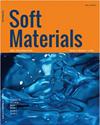Langmuir and Langmuir–Blodgett films of aromatic amphiphiles
IF 1.4
4区 材料科学
Q4 MATERIALS SCIENCE, MULTIDISCIPLINARY
引用次数: 2
Abstract
ABSTRACT Amphiphiles are molecules that contain two discrete segments – a water-soluble hydrophilic part (head-group) and a water-insoluble hydrophobic part (tail). The structural variations possible with the head-group part are enormous and numerous amphiphiles have been designed in this way. On the other hand, the structural variations feasible for the hydrophobic tail part are rather limited. Saturated aliphatic hydrocarbon chains are predominantly found in most of the amphiphiles. Unsaturated aliphatic hydrocarbon chains (n-alkenyl or n-alkynyl chains) also serve as the hydrophobic tail part in many of the amphiphiles. Amphiphiles, wherein the hydrophobic tail part is made up of aromatic moieties (alone or in combination with aliphatic chains) are less frequently encountered compared to the other two types. Many of these aromatic amphiphiles, the focus of this review article, are known to form different types of assemblies including Langmuir and Langmuir-Blodgett (LB) films. In this review, we will provide an account of the different types of aromatic amphiphiles that have been reported and highlight their properties and applications at the air–water and air–solid interfaces.芳香两亲体的Langmuir膜和Langmuir - blodgett膜
摘要:两亲分子是包含两个离散片段的分子,一个是水溶性亲水部分(头部),另一个是不溶于水的疏水部分(尾部)。头部可能的结构变化是巨大的,许多两栖动物都是以这种方式设计的。另一方面,疏水尾部可行的结构变化相当有限。饱和脂肪烃链主要存在于大多数两亲物中。不饱和脂族烃链(n-烯基或n-炔基链)也作为许多两亲物的疏水尾部。与其他两种类型相比,疏水性尾部由芳香族部分(单独或与脂族链结合)组成的亲双试剂的出现频率较低。这些芳香两亲物中的许多,这篇综述文章的重点,已知可以形成不同类型的组装体,包括Langmuir和Langmuir-Blodgett(LB)膜。在这篇综述中,我们将介绍已报道的不同类型的芳香族两亲物,并强调它们在空气-水和空气-固体界面上的性质和应用。
本文章由计算机程序翻译,如有差异,请以英文原文为准。
求助全文
约1分钟内获得全文
求助全文
来源期刊

Soft Materials
工程技术-材料科学:综合
CiteScore
2.90
自引率
0.00%
发文量
21
审稿时长
2.2 months
期刊介绍:
Providing a common forum for all soft matter scientists, Soft Materials covers theory, simulation, and experimental research in this rapidly expanding and interdisciplinary field. As soft materials are often at the heart of modern technologies, soft matter science has implications and applications in many areas ranging from biology to engineering.
Unlike many journals which focus primarily on individual classes of materials or particular applications, Soft Materials draw on all physical, chemical, materials science, and biological aspects of soft matter. Featured topics include polymers, biomacromolecules, colloids, membranes, Langmuir-Blodgett films, liquid crystals, granular matter, soft interfaces, complex fluids, surfactants, gels, nanomaterials, self-organization, supramolecular science, molecular recognition, soft glasses, amphiphiles, foams, and active matter.
Truly international in scope, Soft Materials contains original research, invited reviews, in-depth technical tutorials, and book reviews.
 求助内容:
求助内容: 应助结果提醒方式:
应助结果提醒方式:


